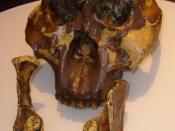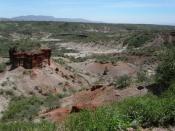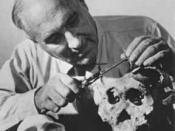Mary
1959 discovery of Zinjanthropus cranium at Olduvai
Started modern science of paleoanthropology (Study of Human Origins)
Louis and Mary Leakey found fossils in Tanzania and Kenya that indicated man's evolution began in East Africa 2 million years ago, far earlier than was believed at the time of the discovery.
in Kenya in 1947, Mary Leakey discovered the skull of Proconsul africanus, an ape-like ancestor of both apes and prehistoric man that ived about 25 million years ago.
1978 she made her most important discovery: footprints frozen for 3.5 million years in volcanic mud that demonstrated that early hominids walked upright much earlier than previously thought.
she found fossilized parts of the upper teeth and skull of a hominid no one had recorded before, eroding out of an area near Bed I. In the next three weeks the Leakeys found more than 400 pieces to comprise an almost complete skull.
It was not too different from remains found in South Africa by Raymond Dart in 1924 and by Robert Broom in 1936. (Those finds had not been accurately dated because of the way they were found and the lack of dating technology.) But the Leakeys thought their find different enough to constitute a new category of hominids, and called it Zinjanthropus boisei. They suggested that it lived 1.75 million years ago
In 1960, Mary Leakey and son Jonathan found another, smaller form of hominid at Olduvai that they believed was different and more advanced. They called it Homo habilis (handy human) because it appeared to be the first human to use tools. The designation of these two new groups raised a great deal of controversy. Zinjanthropus has since been put by most scientists into the Australopithecine genus, which the South African finds also belong to, though in different species. Homo...


